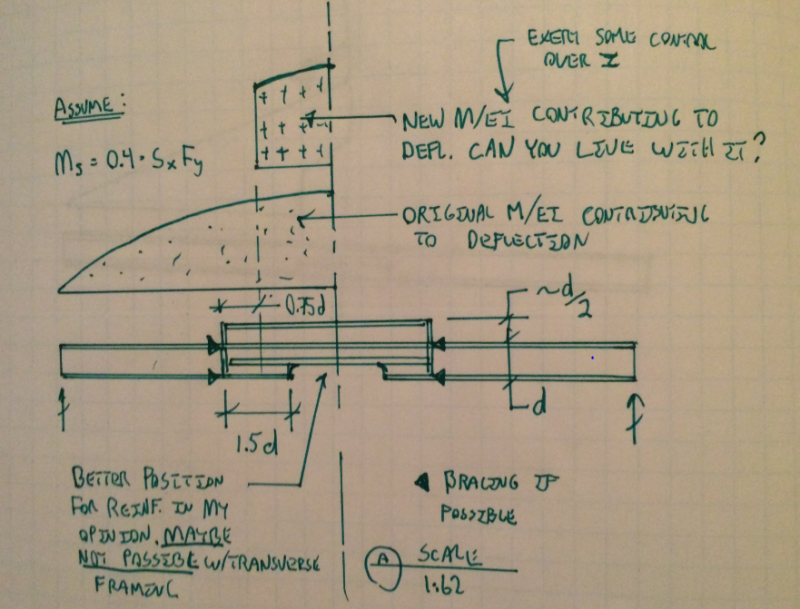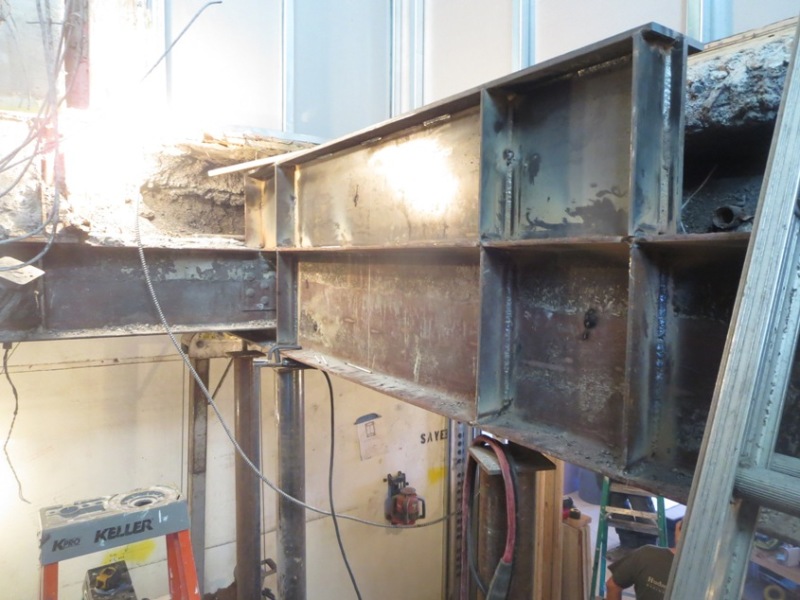bookowski
Structural
- Aug 29, 2010
- 968
- This is a penthouse floor steel beam in a 1920's 20ish story building, construction is steel beams with concrete floors
- The original design did something clever & annoying. Because the penthouse had a unique layout the columns don't continue, instead they used single angle columns and stuck them all over the place in partition corners. I have original drawings but can barely read them so I can't figure out all of the framing or column locations.
- I need to modify a beam that carries one of these transfer posts. Since I can't figure out the framing I can't figure out the load on the beam
- I need to cut about 1/2 of the bottom of the beam for 3'-10" wide (new stair passing under). Since I don't know the load on the beam my approach is to reinforce to provide a new beam with >> Sx and >> Ix
Part of my concern here is that this beam passes into another residence that we have nothing to do with. It also supports a transfer post which in turn supports framing that goes outside of our client's unit. So any movement/issues may telegraph into neighbors, all of which are very expensive and likely contain cranky old ladies.
See attached sketch. The plan would be to build a kinked beam in place prior to cutting. One concern that I have is that the beam obviously needs to deflect to engage this reinforcing, how much might be tricky to figure out without knowing the loading. I could assume some service stress now - say 50% of Fy is conservative and do some analysis to figure out deflection.... I don't want to jack it much for fear of the same problems in reverse. Do I estimate deflection and jack say 1/2 of that? Don't jack at all but provide >>> Ix than I have now so that it takes very little strain to engage? Or is this just silly?
- The original design did something clever & annoying. Because the penthouse had a unique layout the columns don't continue, instead they used single angle columns and stuck them all over the place in partition corners. I have original drawings but can barely read them so I can't figure out all of the framing or column locations.
- I need to modify a beam that carries one of these transfer posts. Since I can't figure out the framing I can't figure out the load on the beam
- I need to cut about 1/2 of the bottom of the beam for 3'-10" wide (new stair passing under). Since I don't know the load on the beam my approach is to reinforce to provide a new beam with >> Sx and >> Ix
Part of my concern here is that this beam passes into another residence that we have nothing to do with. It also supports a transfer post which in turn supports framing that goes outside of our client's unit. So any movement/issues may telegraph into neighbors, all of which are very expensive and likely contain cranky old ladies.
See attached sketch. The plan would be to build a kinked beam in place prior to cutting. One concern that I have is that the beam obviously needs to deflect to engage this reinforcing, how much might be tricky to figure out without knowing the loading. I could assume some service stress now - say 50% of Fy is conservative and do some analysis to figure out deflection.... I don't want to jack it much for fear of the same problems in reverse. Do I estimate deflection and jack say 1/2 of that? Don't jack at all but provide >>> Ix than I have now so that it takes very little strain to engage? Or is this just silly?


